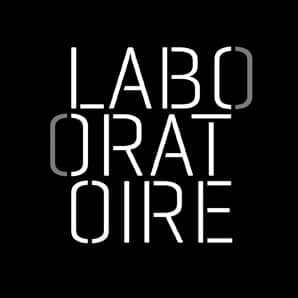Feb 19, 2012 | Laboratoire en
“retorts” is a lasting luminous installation, springing from the traditional plays of lights and shadows in Arabian architecture and enriched with the imaginary of contemporary artists working all over the world.It takes place right in the heart of Algiers : the famous Tunnel des Facultés.
Walking or driving into the tunnel, the passer-by will enter an immaterial work of art, taking in its whole perception. This town-scale installation is grafted onto the public lighting network of Algiers so as to be switched on automatically and stage a new work of art every hou
Designed by artists whose formal and symbolic research is about light and shadow, these light etchings have crossed the planet to carve here, in the womb of Algiers, a multifarious imagery, evocative of both the particular and the universal.
The guest artists are Rachid Koraïchi, Daniel Laskarin, Farid Belkahia, William Kentridge, Gonçalo Ivo, Ene Kull, Ammar Bouras, Liz Rideal, Pinaree Sanpitak, Jyoti Bhatt, Richard Prince, Abderrazak Sahli, Meelis Salujärv, Gülsun Karamustapha, Ester Grinspum, Manisha Parekh, Denis Martinez, Rekha Rodwittiya, Sumi Wakiro, Lu Shengzhong, Nicola Durvasula, Adel El Siwi, Adlane Djeffal, Jacqueline Fabien.



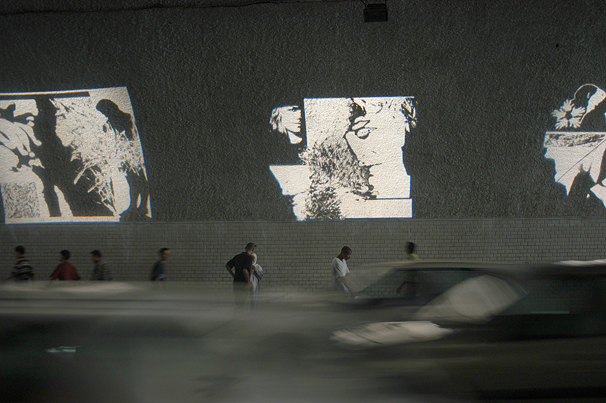
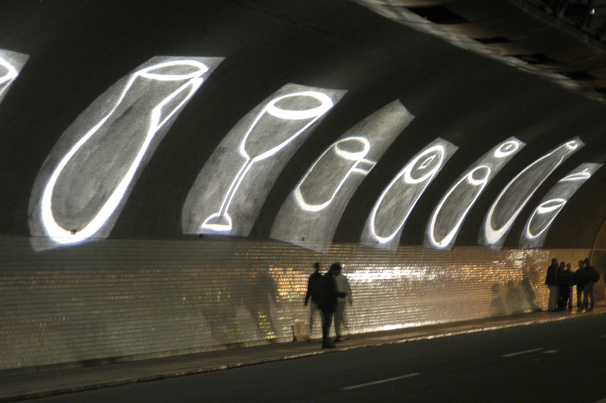
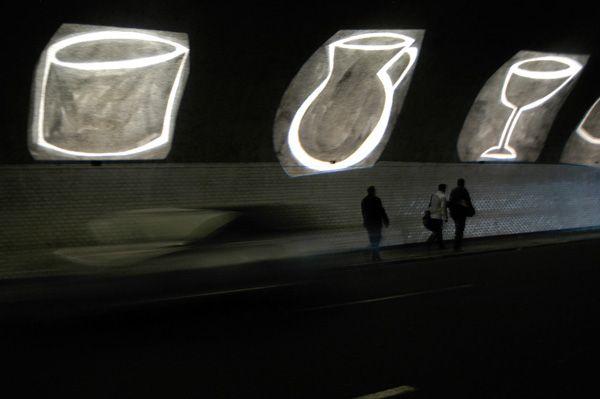
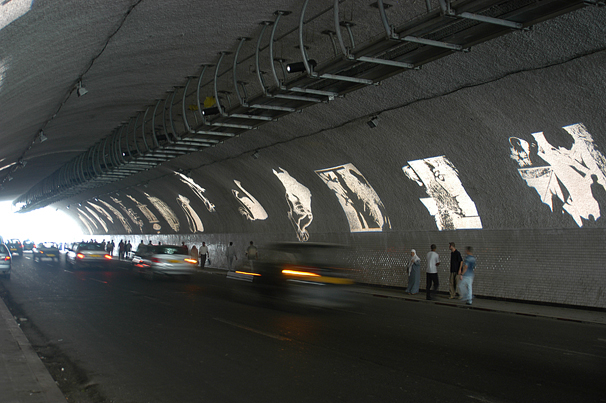
A few tricks to tame the shadow
« retorts» is dedicated to the man-in-the-street, the tireless walker in the Tunnel des Facultés. I have spent so many hours watching him cross the Tunnel since my first visit in January 2002, guided in Algiers by Rachid Karachi! In turns easy-going, careless or exhausted, sometimes walking alone but most of the time in compact clusters swaying across together, it is never the same man nor the same woman who dives into the Tunnel and crosses the tube, immersed in the inner heart of Algiers, to re-emerge in the sun a few minutes later. Maybe there is nothing unusual in the renewed experience, yet it brings one on intimate terms with the daily underground town, its ancient foundations and moods, the womb of dreams, shadows and lights.
Lights, precisely! Now the passer-by will enter light, being totally immersed in it. Each crossing will be a unique experience to him as space will wrap him anew. Each carving of light will have crossed the planet to be inscribed here like a scratch or an etching, sometimes like a tattoo or a scar. For behind each work stands a sort of dazzling proliferation of the world, the dizzy diversity of life, there is an artist alive somewhere in the world, who from Cairo to Bangkok offers Algiers his own vision of light, his innermost recipe to tame shadow.For this first opus, here are the cocktails of shadows and lights from Ammar Bouras, then the dazzling epics of Rachid Koraichi, next the genii from the Egyptian Adel el Siwi, the cut out figures of Gülsun Karamustapha, and come from the Canadian Far West, Isle of Vancouver, the silhouettes of Daniel Laskarin.
Other Opus will follow, testifying to other practices in the world, other frail subtle tricks transmitted from Johannesburg or from Baroda.
Those impalpable images, whose life lasts as long as they persist on the retina, will all the same deeply implant in the heart of Algiers a daily complicity with foreign lights.
Philippe Mouillon
Feb 19, 2012 | Laboratoire en
Ground scars, threads between two dizziness or dust web between two « crossings » creates an original dialogue between the conquest of the mountain landscape by walking, and the progression of the words, memory and ideas.
Four writers, Pascal Amel, Jacques Darras, Jacques Lacarrière and Hervé Planquois together with the photographer Maryvonne Arnaud, associate their looks and confront their perceptions of the same territory, the Étançons valley at the bottom of the south face of the Meije
« crossings» is a true new experiment in the artistic logic of Laboratoire, usually rooted in urban contexts, since it is here a natural site, particularly imposing, where there’s almost no human-beings
Both the images and the words that compose this installation running along a path create a contemporary imaginary of the high mountains.
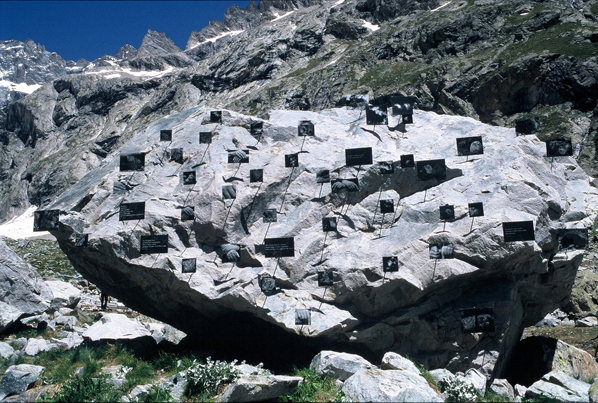
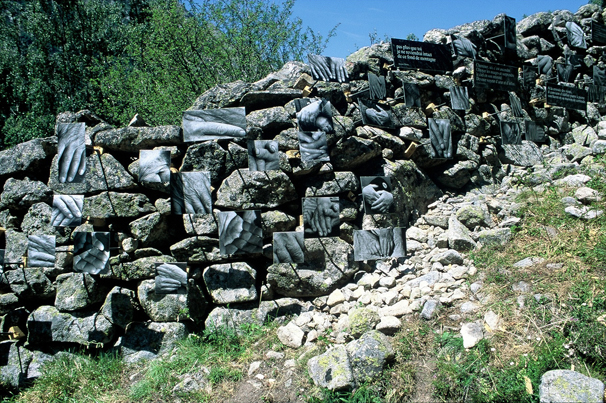
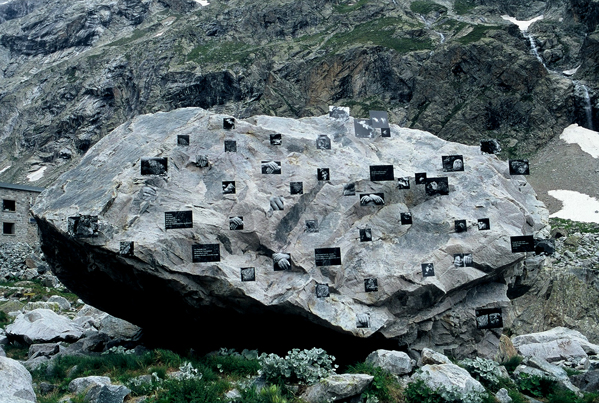


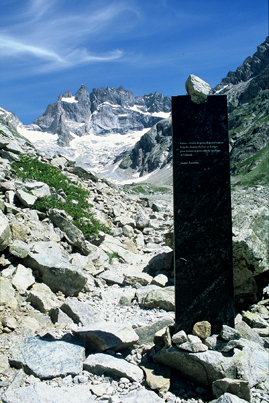
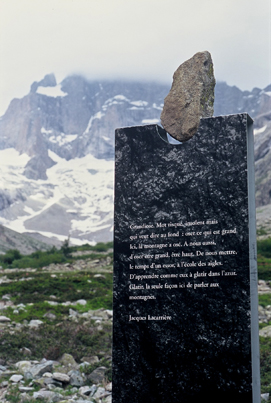
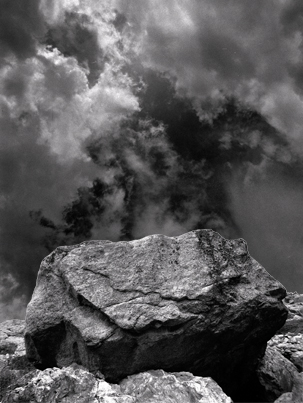
ORIGINAL TEXT BY JACQUES LACARRIÈRE
Cicatrices du sol, fils entre deux vertiges ou toiles de poussière entre deux horizons ?
Tracés par les milliers de pas des cheminants, ils sont voies d’aventure et réseaux de patience, miroirs et sceaux de nos efforts. Et sur chacun de leurs versants on peut lire partout l’ubac de nos fatigues.
Cheminer, ici, c’est ascendre. Côtoyer les nuages et surprendre le ciel en son intimité. Devenir voyeur d’azur et d’infini.
Au bout de ce chemin des cimes, je lis cette inscription : pèlerin des nuages, ici commence l’oratoire des vents.
Pérégriner : le plus beau verbe pour dire jadis le sens et le but du voyage. Pérégrin : le plus beau mot d’antan pour dire l’oblat et le pratiquant des chemins. Pèlerin : son double d’aujourd’hui, son frère en cimes et en vertiges.
Au terme de la montée, soudain et comme inattendu : le ciel. Pour lui, les monts s’écartent, les vallées s’incurvent, l’horizon se déploie. Et quel plaisir de sentir et savoir que là-haut, tout à l’heure, le ciel vous donnera audience. À condition que tout soit clair. En lui et surtout en vous.
Grandiose. Mot risqué, insolent mais qui veut dire au fond : oser ce qui est grand. Ici, la montagne a osé. À nous aussi, d’oser être grand, être haut. De nous mettre, le temps d’un essor, à l’école des aigles. D’apprendre comme eux à glatir dans l’azur. Glatir, la seule façon ici de parler aux montagnes.
Pierres amoncelées. Pierres éparpillées. La Terre elle-même jadis a dû choisir : rassembler ses enfants ou bien les disperser aux quatre vents. Enfants des quatre vents, les pierres des montagnes.
Sous la houle figée des versants, chaque pierre est balise immobile, écume pétrifiée de la mémoire des glaces.
Ayons toujours en vue l’humilité des pierres. Lourdes ou légères, denses ou friables, elles demeurent indifférentes aux joies, insensibles aux remords, étrangères à tout ressentiment. C’est pour cela qu’elles font partout cortège aux pentes comme aux gouffres, aux chemins comme aux cimes, aux neiges comme aux vents. Elles sont parures des solitudes et parements des altitudes. Demeurer où le sort les a jetées ou rejetées et résister au temps est leur unique but. Ayons toujours en vue la patience des pierres.
À la croisée des vents, il convient d’édifier pierre à pierre son havre et sa maison de certitude.
Cairns : bouées de pierre disposées tout au long des chemins d’éclairs et d’orages pour orienter et pour aider les naufragés de l’altitude.
Une à une, sur le socle nu des saisons, ces pierres déposées, distillées par le ciel, comme les stalactites de l’azur.
Je suis seuil et je suis chemin.
Je suis pierre qui dit l’horizon.
Je suis l’enclos des pas nomades.
Je suis paume où se lisent les lignes de l’ailleurs.
Trop loin. Trop lourd. Trop immobile. Roc ancré dans le sol, le sol inéluctable après les lendemains d’ivresse immaculée. Dépôt ou résidu d’un vertige glaciaire ? Débris ou déchet porté, emporté, transporté dans l’anonymat des moraines, et déporté dans les enclos du vent ?
Depuis des millions d’années, je gis. Orphelin du froid.
Lentes reptations des glaces qui avancent, oppressent puis se retirent. Et qui m’ont laissé là, témoin de leurs élans, de leurs désirs inaboutis.
Témoin aussi des griffes et des serres du vent : ces gerçures, cassures, vergetures, ces lézardes sur la peau fossile du temps.
Et maintenant, devenu nuit, livré aux ecchymoses des saisons, aux fantaisies du vent, aux érosions du temps, qui me délivrera du châtiment d’être immobile ? Qui me restituera la douceur erratique ?
Jacques Lacarrière
Feb 19, 2012 | Laboratoire en
At nightfall, the quays along the Isère River, in the historical heart of Grenoble, open to the world. Fragile and impalpable images, simply made up of shadows and lights, drift along the stream, like a vast frieze underlining the town.
These images have crossed the world to get here. They have been specially created – on a canvas designed by Philippe Mouillon – by artists living around the world, in Egypt or Canada, in Brazil or Japan
Once in Grenoble, the original images are integrated in an experimental technologic prototype designed on Gaz Electricité de Grenoble’s initiative in collaboration with Philips-lighting. They are blown-up on the retaining wall of the quays by a discreet network of optical fibres.
This installation allows the town to live a new and dreamlike life at night. They forgotten quays, exhausted by the intensive traffic, become a place of walk and harmony.
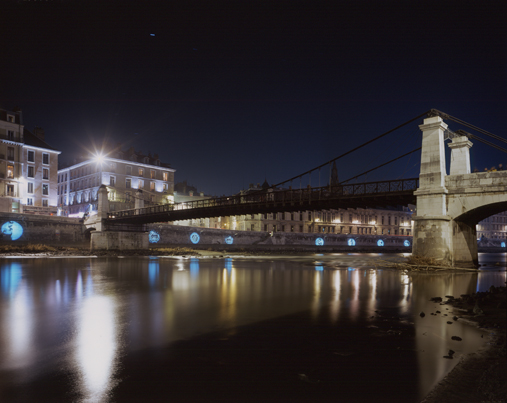
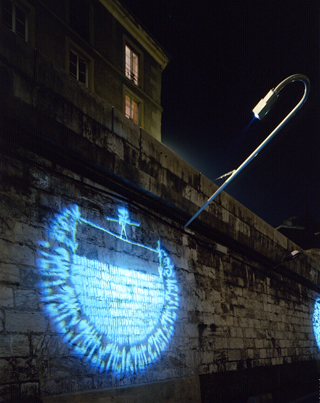

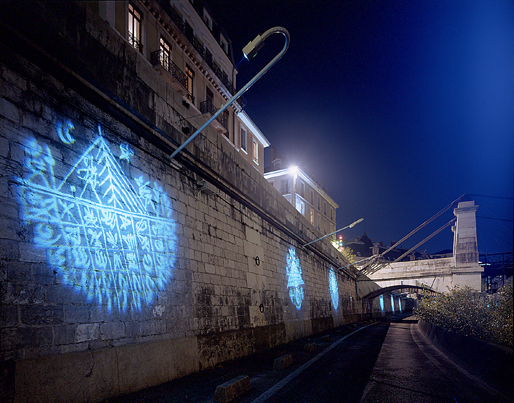
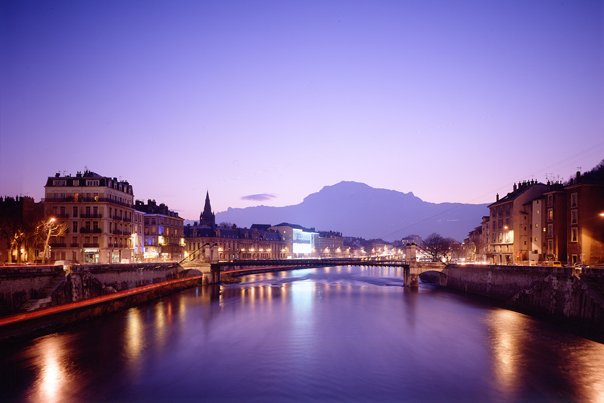
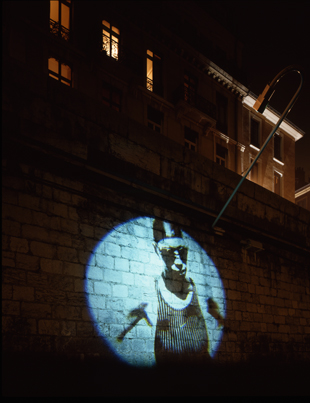
Drawing by Lu Sheng Zhong

Drawing by Rachid Koraichi

Drawing by Rekha Rodwittiya

TEXT BY JACQUES LACARRIÈRE
What is the use of a river? What is the use of a river? The question is hardly ever asked. As for the sky and the earth its existence goes without saying. For a long time rivers have been viewed as a source of drinkable water, a free waterway moving downstream from town to town to reach the sea, as a reservoir of fish one may catch and water fowls one may hunt. Such are the folk tales, the human history of the river at the time of horse-drawn barges and of punts and craft. But rivers have other uses, more for games and less for work, to swim and dive and probe its intimate depths, to sunbathe on their small sand islands, to dream on their banks, imagine their estuaries, the seas into which they flow and the distant Polynesias.
But Heraclites says : “The river is always a Here and a There.” Somewhere else, but also a language, the speech of riverbanks, friendly waters, mud islets, streams, deltas. This language puzzled me, this grammar of swirls and streams either slow or madly swift, waters running from different places.If streams lose their names as soon as they meet a river this doesn’t mean they also lose their distinctive water, I mean the very nature, the density, the singular personality of their water. This is the reason why every river has a history, almost an epic, a long run tale, an aquatic story. When it springs forth it is often but a trickle without a name, without a fate. But as soon as it asserts itself, carries on, digs its way into the incline of the slopes and is framed by the scenery, then it takes on a name, its own name, it can say “I”. But fast enough, while it flows down, others will join him, mingle their waters with his, and the river “I” will lose his identity and say “We” instead. And when this “We” reaches his end and is united with the sea, merges into the vastness of the ocean, he will then lose both his “I” and his “We” and become “All”. Surely there is, in the depths of the Atlantic, rivulets of water still tasting of the Loire, but soon absorbed, drowned into the cosmic taste of the sea, this taste of universal salt.
A river is made up of a thousand different sources and his riches and his reason for being and flowing is the interblending of its waters.
Every river is half breed and interbred. And I no longer want to be told about Roots! I well know the trees. I have grown and matured in their branches, but trees can tell us nothing other than their native soil. They know nothing of the whole world. The whole world can only be taught by rivers on this earth and by migratory birds in the sky.
Rivers are migrating waters, messengers of the universal.
Jacques Lacarrière
Feb 19, 2012 | Laboratoire en
Maryvonne Arnaud installs a man’s and a woman’s hand, palm out-stretched, etched in the floor of the new law courts of the Melun city built by Françoise-Hélène Jourda
By their great size, these images make it possible to enter the memories of one’s life, accumulated in the lines, in the intimate details of the skin or the tracks of previous wounds. But it’s an illusionary opportunity, since our exploration remains incomplete.
These offered palms, seemingly open as an interface between « I » and « the other », maintain the filiation with the primitive hands of the art at the dawn of humanity.When walking on these photographs set in the floor, one should remember this arrogant and disenchanted text by Jean-Paul Sartre, to conclude his biography:
« At the end, what’s left?
A whole man
Composed of all men
And as good as all of them
And no better than any. »



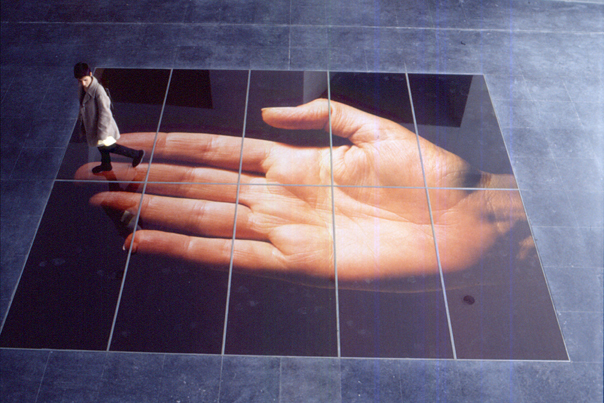
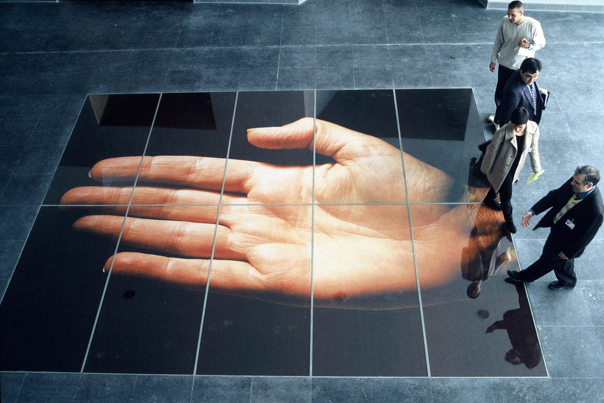
Feb 19, 2012 | Laboratoire en
Third stage of Legend(s), « It is not by thirst that the crocodile comes out of the river to go on shore lick the morning dew » continues the process initiated in 1994 in an ordinary French suburb confronted to racism, then carried on in Bosnia-Herzegovia during the war.
Original photographic portraits taken by Maryvonne Arnaud in different African cities are sent to writers from Africa who live further and further away from the place where the photos have been shot. It is up for them to tackle with these portraits of unknown faces and to catch the elusive, the invisible, the unreadable, through captioning them..
« Legend(s) » deals with otherness, that is to say the dreadful process of affabulation produced by each meeting with the face of others. The intuitive stories of the associated poets help us to break cover the isolationism in order to discover the stranger without eliminating disorder, uncertainty, without clarifying or prioritizing.The associated writers were Pius Ngandu Nkasham, Patrick Chamoiseau, Tanella Boni, Kangni Alemdjrodo, Ahmadou Kourouma, Jean Luc Raharimanana, Tierno Monénembo, Frédéric Bruly Bouabré, Mazisi Kunéné, Leila Sebbar, Aminata Sow Fall and Abdourahman Waberi.
Created in Abidjan, this travelling exhibition was displayed in Dakar, Cotonou, Lomé, Niamey, Bobo-Dioulasso…
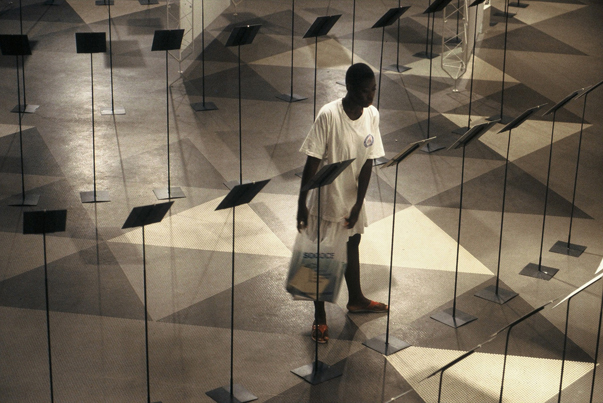
Download the order form
ORIGINAL TEXTS:
Ici, dans le cercle de tous les vertiges, tu as marqué la présence d’une légende surgie des temps qui n’existent plus.
Puisque tu portes un calicot blanc traversé des fables initiatiques. Puisque sur ton front apparaît un signe imperceptible qui indique les versants des montagnes rêvées. Puisque le collier de ta barbiche blanche ramène la mémoire vers les bosquets interdits. Puisque ton regard…, mais pourquoi ne hurle-t-il pas dans la tempête, ton regard ? Mais pourquoi ne peuvent-ils pas exister, ces temps lointains ?
Pius Ngandu Nkashama
===============================
Tout possible.
Mais le vivre déjà
compte semailles trop amères.
Et la joie innocente
suppute les fleurs tombées.
Patrick Chamoiseau
===============================
J’ai vu mille choses de mes yeux-miroirs
J’ai entendu mille versions des exploits de mon homme
Dans les rues de la ville
Je ne sais plus où il a traîné ses vies multiples
D’homme du grand jour d’homme de la nuit
Des milliers de sourires l’accueillent à chaque pas
Je passe ma vie unique à l’attendre
A regarder le temps qui me gave me dévore
Au seuil de quelle demeure a-t-il ôté ses babouches
Je ne sais pas s’il sera là demain
Je travaille de mes mains du matin jusqu’au soir
Je tisse le pagne de son absence infinie
Mais ma peau de soleil ignore
La tristesse de l’absence la paresse de la présence
J’attends avec joie le retour du conquérant
Tanella Boni
===============================
Rat des villes. Rat des villes shooté à “Santa Barbara” et “Dallas”. Villageois planétaire, évidemment. Coxeur. Apprenti-chauffeur. “Coiffeur diplômé de Paris”. Mécanicien d’enfer. Philosophe urbain. Dealer. Tireur du diable… sapeur. Don Juan. Inventeur. Soukousseur. Chair à canon. Imitateur. Machin vitriolique historiquement fiché, toujours ségrégué, Black is beautiful. Beautiful, jeune, et désenchanté. Black vit au cœur de la ville grise, l’interminable labyrinthe le long duquel s’allument et s’éteignent les phares de son improbable modernité. Black a l’air d’un taxi collectif abandonné en pleine autoroute, et qui attend son pétrole pour repartir butiner l’horizon des quadratures. Des millions d’années, déjà, qu’il attend. Alors, de temps en temps, il klaxonne et allume les phares du taxi en panne.
Kangni Alemdjrodo
===============================
Nous sommes riches, trop riches en terres, en enthousiasme, en paroles, en danses. Trop pourvus pour devenir miséreux comme ils le prédisent. Ce n’est pas par manque d’eau que le crocodile sort du fleuve pour aller sur la berge lécher la rosée du matin.
Ahmadou Kourouma
===============================
Au fond de l’abîme des amours, baigné de la senteur des tranquillités, je suis l’être en dérive qui attend d’échouer entre tes seins.
Jean Luc Raharimanana
===============================
Ni Ponant
Ni Levant
Mais les failles d’un dos fouetté par les pluies
Les brûlures d’un ventre qui, croit-on, a fini de donner
L’amour d’une vie sèche par absence d’amour
C’est par-là qu’il faut aller le chercher
le charme délétère du soleil
Tierno Monénembo
===============================
Cet homme ne serait pas “né” s’il avait su d’avance la réelle condition de cette terrestre vie. Sa tenue symbolisant la “civilisation européenne”, l’horreur qu’exprime son “visage” semble décrire irréfutablement la diabolique panique dans laquelle se déroule la “Guerre européenne”.
Frédéric Bruly Bouabré
ORIGINAL PORTRAITS :
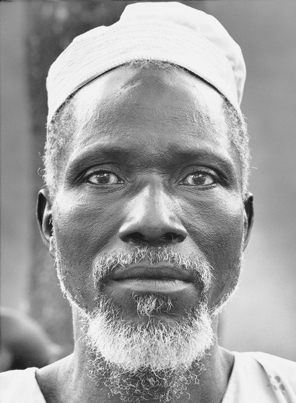
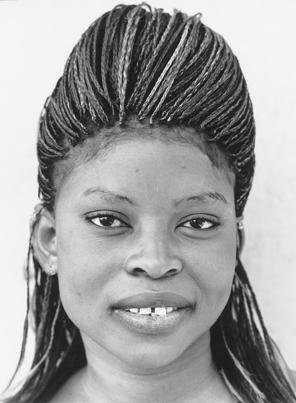
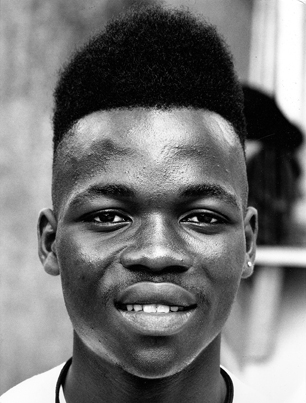
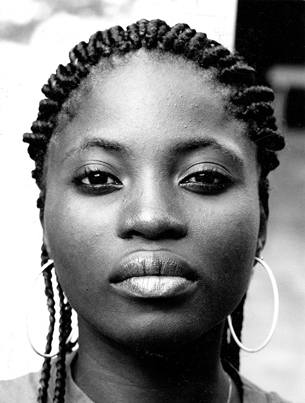
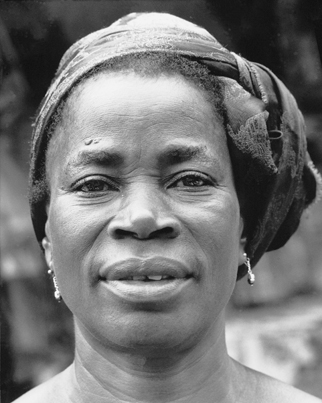
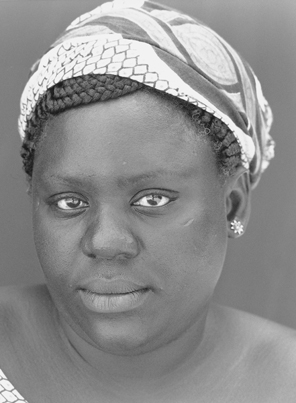
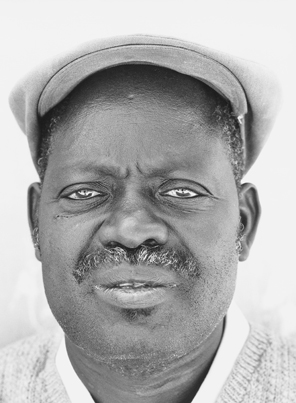
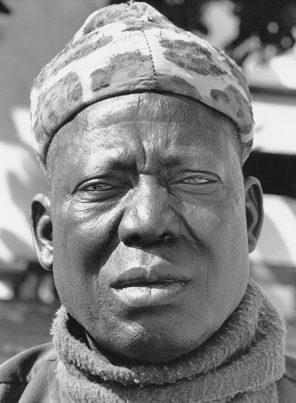
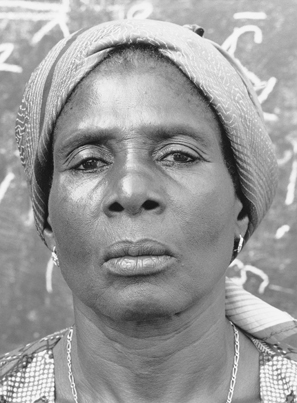
Feb 19, 2012 | Laboratoire en
Legend(s) is a creation initiated in 1994 in Echirolles, a suburb of Grenoble, having to face a difficult coexistence of communities. The idea was then developed Sarajevo, at the time of the crazy logic of ethnic purification, then in Abidjan and Dakar, these suburbs of the world where coexistence was becoming unimaginable.
When elaborating « Legend(s) », Philippe Mouillon has in mind this sentence and the famous press photographs showing the women of so many countries in search of their lost son or husband, as well as this sentence from Gilles Deleuze: “We are always experiencing the confabulation of the other”.
He had witnessed city after city this new daily neighbourhood of a different scale, global, and he had felt an imperative to think out and invent new symbolic landmarks.
Legend(s) is a work of art in process: firstly, Maryvonne Arnaud portrays anonymous inhabitants. This gesture is achieved with such humility and such resolution that she is allowed to reach a rare quality of intimacy with the people she photographs. She tells them what she means to do straight away and quite simply. Her photographies are taken full face, quite close, so that each individual stands out freed from the social characteristics attached to this environment or clothes.
Ten portraits of men and five portraits of women are then chosen and sent to twelve writers who live further and further away from the place where the photos have been shot, as if on concentric circles framing the epicentre of the event.
The original prints, once in the hands of each writer, paradoxically generate intimacy as in a family album of unknown ascendants. Each writer, inspired by this proximity with the anonymous face can then write legends. All writers legend all the portraits: the result is a teeming multiplicity. This multiplicity is then recreated by associating the real-scale images and their legends.
Légende(s) carefully blends into amalgam the spectator’s fate, the writer’s experience of the world, and the impalpable reality of the photographed subject. Identity, usually understood as rooted, unique, sometimes atavistic, can be widened and diversified. Legende(s) thus opens a space where the singular can mix with the universal, allowing an insight in someone else’s thoughts. Someone else who is no longer a strange foreigner, but can be ranged among my folks.
ORIGINAL IMAGES BY Maryvonne Arnaud,
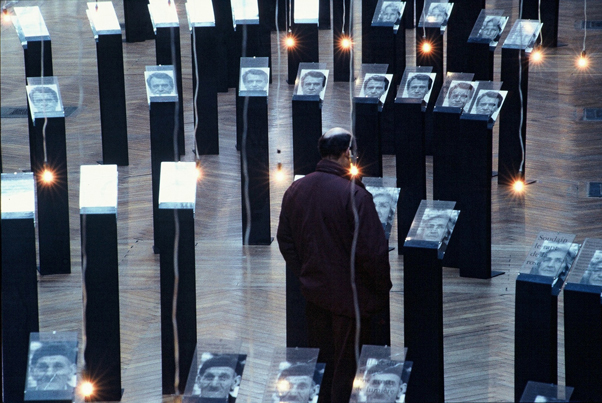
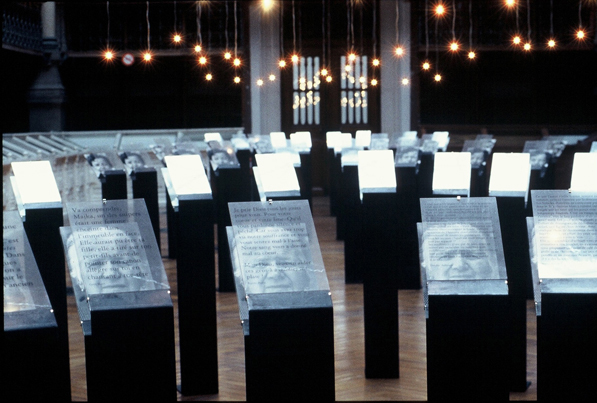
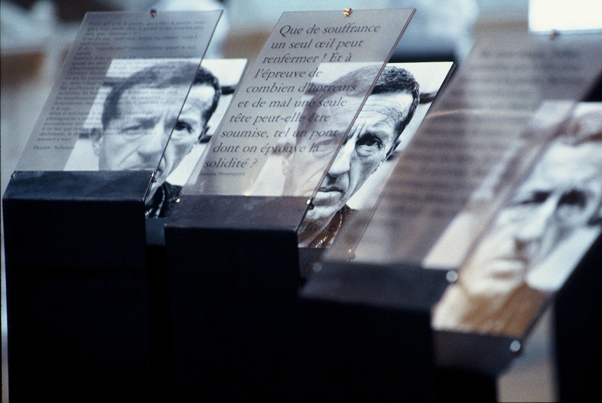
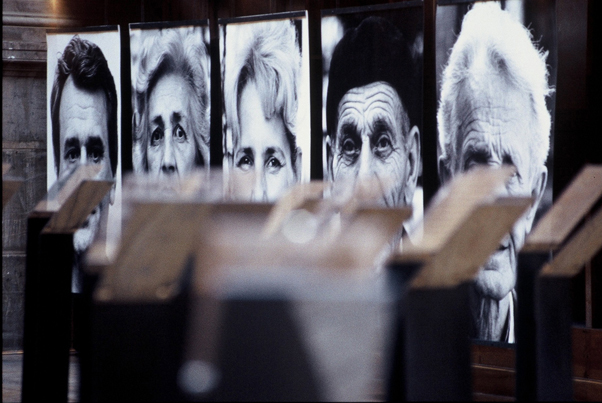
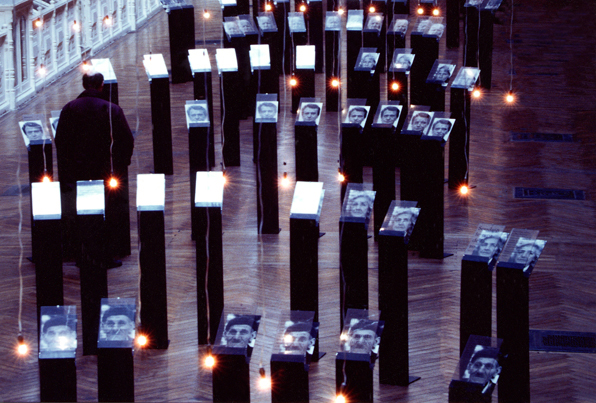

ORIGINAL TEXTS BY Velibor Colic´, Vidosav Stevanovic´, Abdelwahab Meddeb, Vaclav Jamek, Eqrem Basha, Ismaïl Kadaré, Jasmina Musabegovic´, Demosthenes Davvetas, Nédim Gürsel, Danièle Sallenave.
I know you can’t sleep at night; neither can I. I look for my lost generation. Most of us need time to live and dance, to play the dance of life rather than the dance of death, to find again what was lost and, besides, all that remains to be found.
In the shelters of Sarajevo, in the ossuaries of Srebrenica, under the boughs of Igman, I search for my generation, burnt to death.
Do not fear for my future. Help me find it.
Eqrem Basha
Close your eyes tight, as tight as you can, and imagine a rose. An ordinary rose, a red one, like those in the garden.
Remain thus for a while and then look again at reality.
Just like a soap bubble the imagined rose will vanish, with its leaves (where a few dew drops gleam) and so will its stem and the inconsolable sword-like thorns.
Of the rose nothing will remain but the scent, which will always enable us to close our eyes and dream this rose anew.
An ordinary rose, red, such as they grow in the garden, this rose I give you, unknown in Sarajevo.
Velibor Colic
In my eyes, the gloomy shadow of war. Must we live? Yes, we have to. But this life will be meaningless if, in peace, victims must be sacrificed again, the murderers rewarded again. This also depends on you who are staring at me.
Vidosav Stevanovic
A song of snow
behind the curtain of wind
Abdelwahab Meddeb
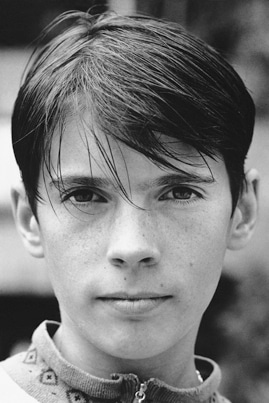
At first this child is handsome, with dark horizontal lines which frame his face, with his freckles, his dark eyes watching, with his long fringe scattered about. Is it a tiny chain, glinting in the hollow between his neck and left shoulder?
As handsome as a promise? The fringe however is slightly over refined, a little too sophisticated. He is a young western boy: one wouldn’t hesitate a minute to give him his skate board and walkman.
It is not evil to be a western boy. It is a mere dream of dignity and simple happiness, of comfort including toilet soap, when one has seen so many maimed limbs and so much rubble.
Besides what do we know of the child’s feet and hands? The promise is what we can’t see: the scar, the secret wound which perhaps he doesn’t know yet, the ingentive which will require him to achieve something.
Vaclav Jamek
Today there’s no school although it is Monday.
And yesterday we didn’t play basket-ball in the yard behind the blocks of flats.
The street is stripped and deserted. Last winter we cut all the trees.
It’s cold and it’s raining.
September has come again and again we have no school.
Velibor Colic
…They’ve opened our school again. Seated on our chairs we’ve counted ourselves. Hardly half of us are present. We’ve studied our mother tongue, physics and Latin…
Our school with broken windows, destroyed walls, cartridge shells, is surrounded by bags of sand. Today we’ve opened our school.
We’ve cleaned our yard from hatred and we’ve counted ourselves. We’ll go on…
Eqrem Basha
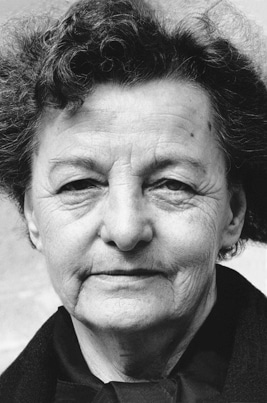
She is a mother. The milk that fed her children was the very substance of humanity.
The same for her body, when she was young. Her wrinkles today, her white hair, the aroma of the bread she baked, all this belongs to the human race. But there are offices, headquarters, clubs, secret meeting places where people think just the opposite.
Ismaïl Kadaré
How much suffering can a single eye encompass? And through how many horrid ordeals and evil trials can a single head be tested? Just like a bridge tested for its reliability.
Jasmina Musabegovic
He has gone away to somewhere else, singing a song whose sealed words have roamed among the ruins ever since the midst of times. Rising above the smoke and huddled together the souls eagerly look for the oxygen of this impenetrable song.
Demosthenes Davvetas
True, I saw little in Sarajevo, almost nothing. For instance I didn’t see the people queueing for bread under a shower of shells. Nor did I see the people killed while carrying water. Nor blood run and dogs drinking it. I didn’t see the neighbouring villages either, with their girls thrown into the river after they had been raped, nor the children run over by tanks, nor those tortured to death. No, in Sarajevo I saw nothing. Not even the little girl wounded by a sniper while she walked back from her mother’s burial. I suffered neither from hunger nor from fear. I didn’t see the people being driven mad living a nightmare from which they’ll never come out. I didn’t see the dead either, but I saw their tombs. The date of birth varied but that of their death was always the same. Because they had all died the last two years. I also saw the ruined houses, the post office building burnt down, and that crowd of cripples suddenly fill the streets. True, I didn’t see that war. But I saw its face. In Sarajevo, my love. I won’t forget.
Nédim Gürsel
Someone who has seen the war, one who has lived through the war, someone who has lost everything in the war and no longer hopes for anything, what does he ask for?
He doesn’t say: help me, listen to my complaint, come to my rescue.
He says: “Look at me” as a child does at nightfall.
Ringing in the cold silence, when totally forsaken, forsaken by all the powers and all aid, man’s final question in the distance echoes Job’s scream: “What sort of face was mine when my mother was not yet born? What sort of face is mine, if no one looks at me?”
Suffering is meaningless and will not be redeemed, people are unconcerned even in their demonstration of pity, the guilty will remain unpunished, and in the end, all will be forgotten.
He knows it.
Then he meets the gaze focused on him by the photographer’s lens.
But this gaze is in no way an answer;
it only makes visible, multiplied and heartrending, the last question of man, when he has relinquished all
“who am I when no one looks at me?”
Danièle Sallenave
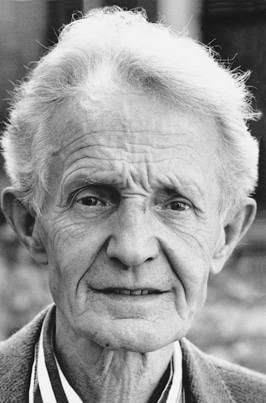
It looks as if our faces now were only one.
As if our grief had become his.
So many times we went and so many times we came back.
The water we drink, the air we breathe, the soil we tread upon… The God we pray, the voice bursts from our throats…
Our beloved dead, our missing, our humiliated relatives…
Our sadness, our immense sadness.
It looks as if our faces now were only one.
His…
Velibor Colic

